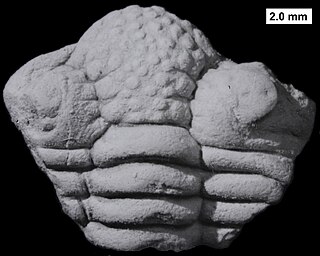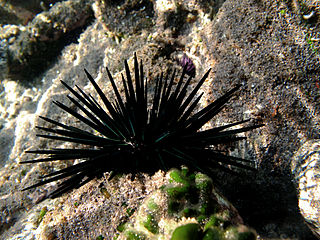
Calymene Brongniart, 1822, is a genus of trilobites in the order Phacopida, suborder Calymenina, that are found throughout North America, North Africa, and Europe in primarily Silurian outcrops. Calymene is closely related to Flexicalymene, and both genera are frequently found enrolled. Calymene trilobites are small, typically 2 cm in length. The cephalon is the widest part of the animal and the thorax usually has 13 segments.

Chonetes is an extinct genus of brachiopods. It ranged from the Late Ordovician to the Middle Jurassic.

Balizoma is a genus of trilobites from the family Encrinuridae established by David J. Holloway in 1980. It has only been found in rocks of Silurian age. Its type species, B. variolaris, is currently the only named species of the genus, and is found in England. The neotype of B. variolaris was collected from the Much Wenlock Limestone Formation at Dudley, West Midlands. That specimen was first illustrated in Sir Roderick Impey Murchison's classic book, The Silurian System. B. variolaris was the original "strawberry-headed" trilobite of Dudley, so-named because of its nodular glabellar tubercles, and well known to early trilobite collectors. Additional species were originally assigned to Balizoma, but were subsequently placed in other encrinurine genera.

Frammia is a genus of trilobites in the order Phacopida that existed during the middle and upper Silurian in what is now the Arctic regions of Canada and Russia. It was described by Holtedahl in 1914, and the type species is Frammia dissimilis. That species was subsequently considered to be a synonym of Frammia arctica. The genus also contains the species, F. bachae Adrain & Edgecombe, 1997, F. hyperborea, and F. rossica. The type locality is the Douro Formation of Cornwallis Island in Nunavut, Canadian Arctic.

The Echinacea are a superorder of sea urchins. They are distinguished by the presence of a rigid test, with ten buccal plates around the mouth, and solid spines. Unlike some other sea urchins, they also possess gills. The group is a large one, with species found worldwide.

Acalolepta australis is a species of flat-faced longhorn beetle belonging to the family Cerambycidae, subfamily Lamiinae.

Acalolepta is a genus of flat-faced longhorns beetle belonging to the family Cerambycidae, subfamily Lamiinae. Its members are found in the Indomalayan realm.

The infraclassis Carinacea includes most living species of regular sea urchin, and fossil forms going back as far as the Triassic.

Stomopneustes variolaris, the black sea urchin or long-spined sea urchin, is a species of sea urchin, the only one in its genus Stomopneustes and only species still alive in its family Stomopneustidae. It is found throughout the tropical Indo-Pacific, with a patchy distribution.
Acalolepta griseofasciata is a species of beetle in the family Cerambycidae. It was described by Stephan von Breuning in 1935, originally under the genus Dihammus. It is known from Papua New Guinea, Vanuatu, and the Solomon Islands.
Acalolepta sikkimensis is a species of beetle in the family Cerambycidae. It was described by Stephan von Breuning in 1935.
Acalolepta magnetica is a species of beetle in the family Cerambycidae. It was described by Francis Polkinghorne Pascoe in 1866, originally under the genus Monochamus. It is known from Micronesia, Moluccas and Indonesia.

Acalolepta permutans is a species of beetle in the family Cerambycidae. It was described by Francis Polkinghorne Pascoe in 1857, originally under the genus Monohammus. It is known from Japan, Vietnam, Taiwan, and China. It feeds on Albizia julibrissin.
Acalolepta montana is a species of beetle in the family Cerambycidae. It was described by Per Olof Christopher Aurivillius in 1916. It is known from Sulawesi.
Acalolepta flocculata is a species of beetle in the family Cerambycidae. It was described by Gressitt in 1935. It is known from Taiwan and China.

Acalolepta fraudatrix is a species of beetle in the family Cerambycidae. It was described by Henry Walter Bates in 1873. It is known from Korea, Japan, China, and Russia.
Acalolepta mixta is a species of beetle in the family Cerambycidae. It was described by Frederick William Hope in 1841, originally under the genus Monohammus. It is known from Australia, and was introduced to the Solomon Islands, Indonesia, Singapore and Vietnam. It feeds on Theobroma cacao, Adansonia digitata, Mangifera indica, Excoecaria agallocha, and Moringa oleifera.
Acalolepta rusticatrix is a species of beetle in the family Cerambycidae. It was described by Johan Christian Fabricius in 1801, originally under the genus Lamia. It is known from Myanmar, India, the Philippines, Malaysia, Sumatra, Sri Lanka, Java, Taiwan, Indonesia, Sulawesi, and Vietnam.
Acalolepta sejuncta is a species of beetle in the family Cerambycidae. It was described by Henry Walter Bates in 1873. It is known from Japan.









